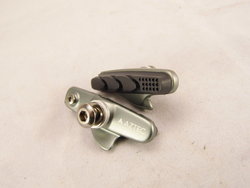The lying YS twin says that the rim problem is more difficult to answer but that he will try.
He will first be a bit pedantic and say that the rims are probably both made from aluminium, not alloy. Alloy just means "mix". But that's beside the point.
When a flexible material like rubber slides over a metal rim it does so not in one smooth sweep but in plenty of tiny little slip-stick motions that move through the rubber like caterpillar-walk waves. The slip starts at the one end in a band as wide as the rubber and it then moves across to the other end, all the time with a stick-action ahead and behind it. Imagine it as a stiff brush being pushed along a very rough surface and you are viewing the motion from the side. You'll notice that an individual bristle hits an obstacle, bends back (as the brush moves forward), then shoots forward and bends back again with the next obstacle and so on. That's called a slip-stick motion.
If that motion happens at a frequency that's compatible with our ears, we can hear it. Otherwise only bats hear you brake. It is that slip-stick motion that causes the noise in brakes (rubber or disk), hinges that squeak and a violin string that vibrates under a moving bow.
The slip-stick motion reduces friction - because half the material loses contact as it jumps to the next position.
Back to brakes.
If the slip-stick motion is too aggressive, then the brake doesn't work as well. In other words, very noisy brakes are not as effective as silent ones. Effectiveness is measured in small units here but as David has discovered, it matters.
In his case it means that the one rim produces too much slip-stick in too large a wave and that has to be reduced.
It can be done by sanding the rim with some wet paper - wet paper being waterproof sandpaper (300-grit or so) in the presence of water. That will destroy the non-conducive surface and bring on a different one that is usually just perfect.
Alternatively, he can go and find a nice long muddy puddle and ride through it, applying brakes all the time.
If you are really geeky, the waves are called schallamach waves (after Mr Schallamach) and can be seen here:
https://www.youtube.com/results?search_query=scmallach+waves
The second video in the link shows it nicely and is easier to relate to rubber bicycle brake pads.

